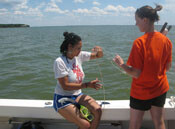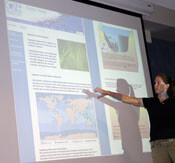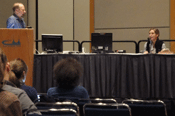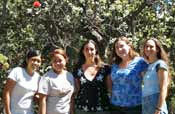New COSEE Center: Coastal Trends
 A new Center for Ocean Science Education Excellence (COSEE) has been established through the collaborative effort of several institutions, including the UMCES Horn Point Laboratory (HPL) and the Integration and Application Network (IAN). IAN's role includes development of communication tools, including the website, which has information on programs and activities, workshops, and an eNewsletter. Media-rich educational materials and classroom unit plans will be available in the coming months. Coastal Trends focuses on long and short term trends in our dynamic coastal systems through workshops for teachers and programs and activities for the general public.
A new Center for Ocean Science Education Excellence (COSEE) has been established through the collaborative effort of several institutions, including the UMCES Horn Point Laboratory (HPL) and the Integration and Application Network (IAN). IAN's role includes development of communication tools, including the website, which has information on programs and activities, workshops, and an eNewsletter. Media-rich educational materials and classroom unit plans will be available in the coming months. Coastal Trends focuses on long and short term trends in our dynamic coastal systems through workshops for teachers and programs and activities for the general public.
Centers for Ocean Science Education Excellence Coastal Trends hosts researcher, educators, and students
 From June 16 to 19, Centers for Ocean Science Education Excellence (COSEE) Coastal Trends welcomed two scientist-educator teams to Horn Point Laboratory in Cambridge, Maryland for an orientation program. Each team includes a scientist, educator, graduate student, and undergraduate student committed to developing effective educational materials for K-12 classrooms. Through lectures, activities, and field trips, the orientation program introduced the teams to research trends in seagrass and dead zones and educational trends in inquiry and critical thinking. During the program, the teams discussed how to incorporate current scientific knowledge into the 5E lesson plan format, adapted from the Biological Sciences Curriculum Study. Over the course of the summer, these teams will conduct research and create educational materials on coastal trends that will be field-tested by teachers. IAN staff will provide science communication and web support to the teams as they develop their materials and assist in the evaluation of the final products.
From June 16 to 19, Centers for Ocean Science Education Excellence (COSEE) Coastal Trends welcomed two scientist-educator teams to Horn Point Laboratory in Cambridge, Maryland for an orientation program. Each team includes a scientist, educator, graduate student, and undergraduate student committed to developing effective educational materials for K-12 classrooms. Through lectures, activities, and field trips, the orientation program introduced the teams to research trends in seagrass and dead zones and educational trends in inquiry and critical thinking. During the program, the teams discussed how to incorporate current scientific knowledge into the 5E lesson plan format, adapted from the Biological Sciences Curriculum Study. Over the course of the summer, these teams will conduct research and create educational materials on coastal trends that will be field-tested by teachers. IAN staff will provide science communication and web support to the teams as they develop their materials and assist in the evaluation of the final products.
Scientist-educator partnerships produce classroom materials
 On July 30-31, the scientist-educator teams, hosted by Centers for Ocean Science Education Excellence (COSEE) Coastal Trends, revealed the classroom materials they created during a six-week program. Each team developed materials for an interactive website where students can explore seagrass and dead zones, examine the trends in these topics, and investigate current research. Activities on the website directly relate to lesson plans that link the concepts on the website to classroom activities and assessment tools for teachers. Over the next few months, these materials will be tested in classrooms and made available to educators and the public.
On July 30-31, the scientist-educator teams, hosted by Centers for Ocean Science Education Excellence (COSEE) Coastal Trends, revealed the classroom materials they created during a six-week program. Each team developed materials for an interactive website where students can explore seagrass and dead zones, examine the trends in these topics, and investigate current research. Activities on the website directly relate to lesson plans that link the concepts on the website to classroom activities and assessment tools for teachers. Over the next few months, these materials will be tested in classrooms and made available to educators and the public.
IAN interns head to graduate schools
 Lucy van Essen-Fishman and Kim Kraeer finished their 10 month IAN internships in May. Both are headed to graduate schools in the fall—Lucy will be traveling to Oxford University, U.K. to study ancient Greek, while Kimmy will be moving to Washington, D.C. to study biology at American University after a summer working as a dolphin trainer at the National Aquarium in Baltimore. The two interns were instrumental in developing and testing the environmental negotiating game "Trade-Off!" and in creating hundreds of new symbols for the IAN symbol library. In addition, they made substantial contributions to the COSEE Coastal Trends website and aided IAN Science Integrators and Science Communicators in a variety of projects throughout their internships. Lucy and Kimmy were wonderful to work with and we wish them great success in graduate school.
Lucy van Essen-Fishman and Kim Kraeer finished their 10 month IAN internships in May. Both are headed to graduate schools in the fall—Lucy will be traveling to Oxford University, U.K. to study ancient Greek, while Kimmy will be moving to Washington, D.C. to study biology at American University after a summer working as a dolphin trainer at the National Aquarium in Baltimore. The two interns were instrumental in developing and testing the environmental negotiating game "Trade-Off!" and in creating hundreds of new symbols for the IAN symbol library. In addition, they made substantial contributions to the COSEE Coastal Trends website and aided IAN Science Integrators and Science Communicators in a variety of projects throughout their internships. Lucy and Kimmy were wonderful to work with and we wish them great success in graduate school.
Telling stories to communicate science
 COSEE Coastal trends frequently uses videos to illustrate how people are connected to the natural world and scientific discovery. Last week, at the American Society of Limnology and Oceanography (ASLO) meeting in Portland Oregon, COSEE Coastal Trends staff had the opportunity to share their work and learn new story telling techniques with scientist-turned-filmmaker, Randy Olson. Cassie Gurbisz submitted the Observing the Ocean video she wrote, edited, and filmed to Olson's workshop session. The video received good reviews and workshop participants offered suggestions for enhancing the story telling components. COSEE Coastal Trends and IAN will continue to explore how to use stories to make personal connections and communicate science.
COSEE Coastal trends frequently uses videos to illustrate how people are connected to the natural world and scientific discovery. Last week, at the American Society of Limnology and Oceanography (ASLO) meeting in Portland Oregon, COSEE Coastal Trends staff had the opportunity to share their work and learn new story telling techniques with scientist-turned-filmmaker, Randy Olson. Cassie Gurbisz submitted the Observing the Ocean video she wrote, edited, and filmed to Olson's workshop session. The video received good reviews and workshop participants offered suggestions for enhancing the story telling components. COSEE Coastal Trends and IAN will continue to explore how to use stories to make personal connections and communicate science.
Communicating corals and climate change in the Pacific Islands
 Earlier this month IAN and COSEE Coastal Trends staff, in partnership with the National Park Service Pacific Island Network, launched the coral reef and climate change scientist-educator team. The team, based in Volcano, Hawai'i, will draw on the diverse skills and backgrounds of its members to create informative and engaging materials that communicate the unique features of coral reefs within the Pacific Island Network. Team members, from across the Pacific Islands of Hawai'i and American Samoa, represent the University of Hawai'i at Hilo, the Pacific Internship Programs for Exploring Science, and Kahuku High School. Over the course of six weeks, the team will design hands-on and virtual activities, create conceptual diagrams, and develop classroom lesson plans that draw on traditional knowledge and current NPS research.
Earlier this month IAN and COSEE Coastal Trends staff, in partnership with the National Park Service Pacific Island Network, launched the coral reef and climate change scientist-educator team. The team, based in Volcano, Hawai'i, will draw on the diverse skills and backgrounds of its members to create informative and engaging materials that communicate the unique features of coral reefs within the Pacific Island Network. Team members, from across the Pacific Islands of Hawai'i and American Samoa, represent the University of Hawai'i at Hilo, the Pacific Internship Programs for Exploring Science, and Kahuku High School. Over the course of six weeks, the team will design hands-on and virtual activities, create conceptual diagrams, and develop classroom lesson plans that draw on traditional knowledge and current NPS research.
Communicating the cultural and ecological importance of coral reefs
 The COSEE Coastal Trends Coral Reef team has wrapped up the first phase of its project with the Pacific Island Network Inventory & Monitoring Program at the National Park Service. Their efforts culminated in a meeting with Park staff to review mock-ups of diagrams, games, activities, and videos created to help students learn about cultural and ecological importance of coral reefs in the Pacific Islands through inquiry and observation. Because it incorporates the ways in which the Hawaiian, Samoan, and Chamorro cultures are connected to corals, stewardship, and sustainability, this module will be unlike the others previously developed by Coastal Trends. The team is now working with web developer Adrian Jones to transform the mock-ups into interactive web pages.
The COSEE Coastal Trends Coral Reef team has wrapped up the first phase of its project with the Pacific Island Network Inventory & Monitoring Program at the National Park Service. Their efforts culminated in a meeting with Park staff to review mock-ups of diagrams, games, activities, and videos created to help students learn about cultural and ecological importance of coral reefs in the Pacific Islands through inquiry and observation. Because it incorporates the ways in which the Hawaiian, Samoan, and Chamorro cultures are connected to corals, stewardship, and sustainability, this module will be unlike the others previously developed by Coastal Trends. The team is now working with web developer Adrian Jones to transform the mock-ups into interactive web pages.

